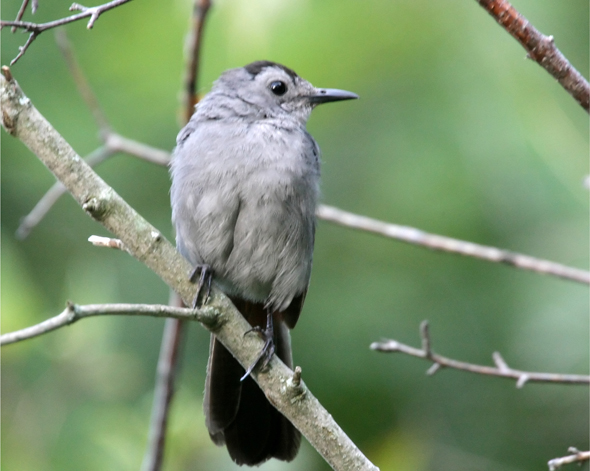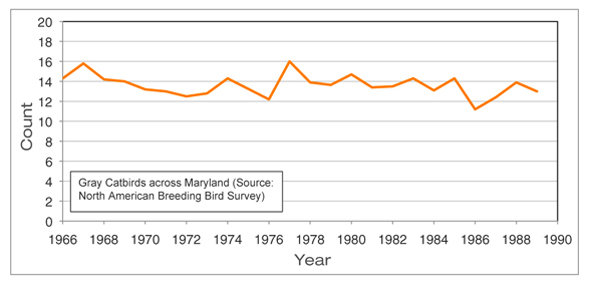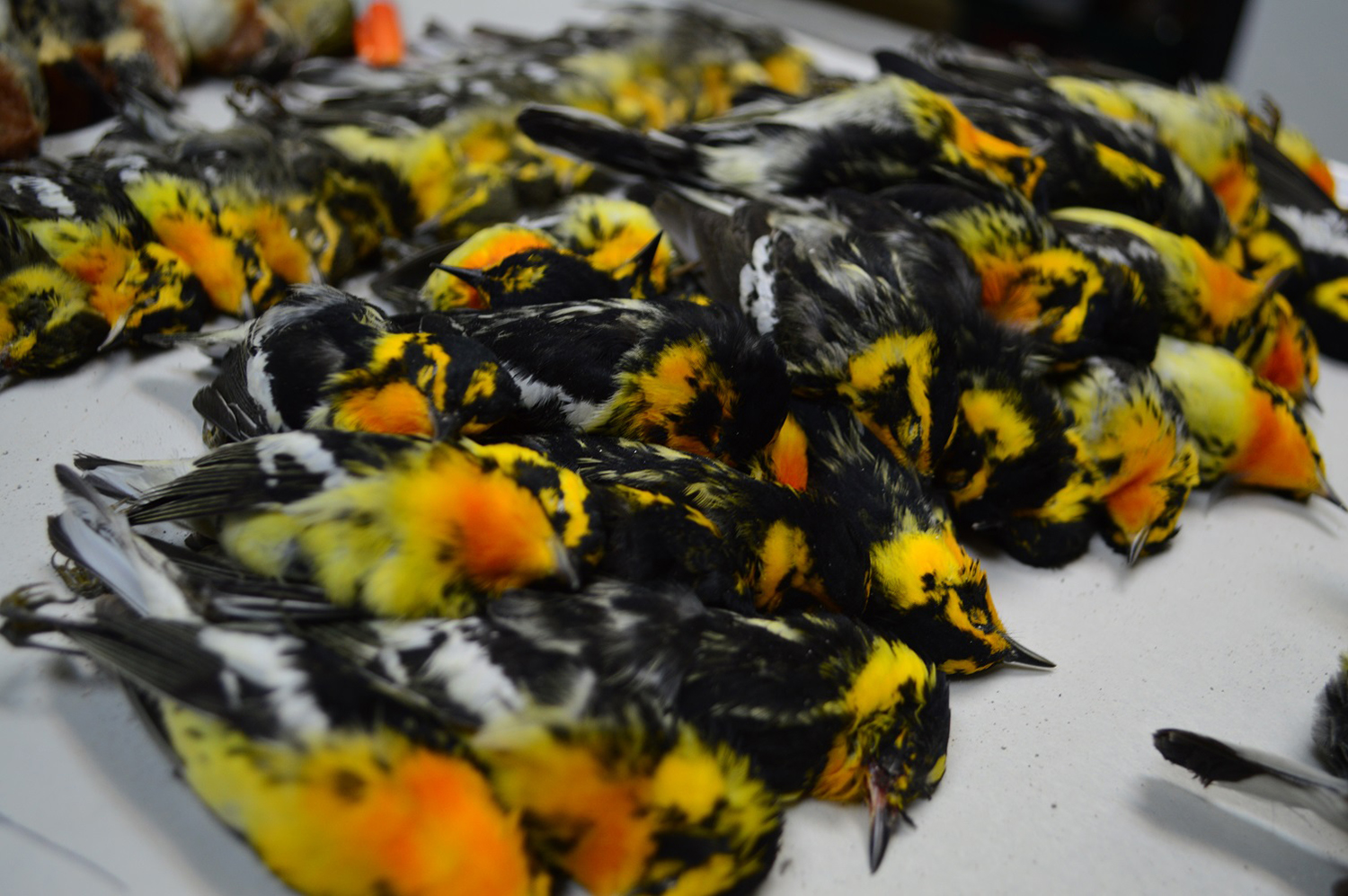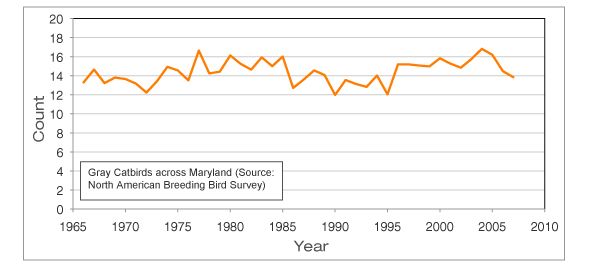 A Gray Catbird in Madison, Wisconsin, USA. Photo courtesy Wikimedia Commons and John Benson.
A Gray Catbird in Madison, Wisconsin, USA. Photo courtesy Wikimedia Commons and John Benson.
According to its website, the Smithsonian Migratory Bird Center is a “national and international leader in the biology and conservation of migratory birds.” When it comes to cats and their potential impact on birds, however, the SMBC apparently has a lot to learn.
Actually, they could use some pointers on professionalism, too—and maybe a refresher on the difference between correlation and causation.
Summarizing a recent study of gray catbird fledglings in the Washington, DC area, the SMBC claims that cats were responsible for “alarmingly high rates of nest predation and fledging [sic] mortality.” But there’s no mention of how such a connection was made. Indeed, “Baby Catbird Survival” offers very little in the way of details. Instead, readers are treated to sophomoric commentary:
“… several guilty-looking cats were found in close proximity to dead birds. Our guess is that closer examination would have revealed feathers in their whiskers.”
This is the Smithsonian? What I wouldn’t give to have been in the marketing meeting where “predation humor” was first proposed as an innovative, sure-fire scheme for attracting new donors and research funding.
Catbird Mortality
The study, spanning two summers, was conducted at three sites, two in Takoma Park, MD, and another—apparently less populated with cats—in Bethesda, MD. Somehow—again, no details are given—radio-tracking technology was used to monitor the mortality of young catbirds.
Results indicate that 85% of nests at the Bethesda site were “successful” (i.e., young catbirds survived long enough to leave the nest), compared to only 34% of nests at the Takoma Park sites. At the Bethesda site, 29% of fledglings survived to eight weeks of age, versus 14% at Takoma Park.
Given the rather dramatic nature of these findings, one might expect some explanation of the research methods and analysis techniques employed. Among the numerous questions left unanswered:
- How was radio-tracking used to distinguish predation from other forms of mortality—or, more to the point, predation by cats from other forms of predation?
- How were the sites selected, and the cats at each site counted?
- What other factors (e.g., population density of humans, abundance of other predators, habitat availability and condition, etc.) might have been at work here?
- What were the sample sizes employed?
At best—and this is being very generous—the results suggest correlation. But, of course, this is very different from causation.
In Proofiness, author Charles Seife uses the relationship between a country’s energy consumption and the life expectancy of its citizens to illustrate the difference. Plot the data and there is an unmistakable trend: as energy consumption increases, so does life expectancy.
“Yes, it’s true that the more power a society uses, the longer its citizens live, on average. It’s equally true, however, that the more garbage a society produces, the longer its people live. The more automobiles people in a society drive, the more newspapers people in a society read, the more fast food people consume, the more television sets people have, the more time people spend on the Internet…” [1]
So, are the Takoma Park cats the cause of catbird mortality? Who knows.
Who’s In Charge?
Exactly who’s responsible for “Baby Catbird Survival” is another mystery (though anonymity is understandable in this case, as it’s difficult to imagine any respectable scientist claiming ownership of something so flimsy and irresponsible). The researcher who oversaw the project, though, is Peter Marra, the SMBC scientist at the center of a recent Washington Post column (of which I was highly critical).
This, of course, is the same Peter Marra who, along with nine of his colleagues, has argued that “trap-neuter-return is essentially cat hoarding without walls,” and called for “legal action against colonies and colony managers.” [2] The authors also call on conservation biologists to “begin speaking out” against TNR “at local meetings, through the news media, and at outreach events.” [2] It’s a message Marra has obviously taken to heart.
There’s no doubt Marra has an agenda. The question is: how might this bias his research?
Untangling the Research
With so few details to go by, it’s difficult to scrutinize Marra’s catbird study. If it’s published, of course, greater transparency will be required. In the meantime, we do have some useful clues that—along with a little detective work—provide some insight.
Counting Cats
As I indicated previously, it’s hard to imagine that the only difference between the Takoma Park and Bethesda sites was the number of cats. Even if that were the case, though, absolute numbers are hardly the whole story. Numerous studies have demonstrated that predation success varies widely among domestic cats: some catch lots of prey while others catch very few—or none at all. [3–7]
That’s assuming they can get at the prey, of course.
Marra is clear in the Post piece that the (alleged) killers “aren’t feral cats; they’re domestic cats allowed to go outside.” But, contrary to what columnist Adrian Higgins suggests, studies have shown that about two-thirds of cats are indoor-only. [8–11] And of those allowed outside, approximately half spend less than three hours outdoors each day. [9, 10]
How sure can Marra be, then, that the areas’ pet cats are responsible for the deaths of young catbirds?
Predatory Habits
The author of “Baby Catbird Survival” claims that “domestic cats typically only decapitate birds and leave the carcass.” Now, I’ve become quite familiar with the research on the hunting behavior of cats over the past year or so, and recall seeing nothing to this effect. I recently revisited some key sources [12–15] just to be sure, and again found nothing to support this assertion. However, it was brought to my attention that some birds will decapitate their prey:
“In urban and suburban settings grackles are the most likely culprits, although jays, magpies, and crows will decapitate small birds, too. Screech-owls and pygmy-owls also decapitate their prey, but, intending to eat them later, they usually cache their victims out of sight.” [16]
“There is little you can do to discourage screech-owls if only because they do their killing under cover of darkness. However, you can recognize their handiwork by looking for partially plucked carcasses of songbirds with the heads missing… Corvids—crows, ravens, jays, and magpies—are well known for their raids on birds’ nests to take eggs and nestlings.” [17] (Interestingly, the author, David M. Bird, was among Marra’s nine co-authors on “What Conservation Biologists Can Do.”)
Again, how can Marra be so sure the cats are the culprits?
Catbird Population
And finally, what about Marra’s claim, as reported by Higgins, that “catbirds in cat-heavy areas are not able to reproduce at a rate that is sustainable”?
Data from the North American Breeding Bird Survey suggest that Maryland’s gray catbird population declined perhaps 7% between 1966–1989, a period during which the state’s human population grew approximately 35%.
 BBS Data: Gray Catbirds Across Maryland (adapted from the Atlas of the breeding birds of Maryland and the District of Columbia)
BBS Data: Gray Catbirds Across Maryland (adapted from the Atlas of the breeding birds of Maryland and the District of Columbia)
Even so, the Atlas of the Breeding Birds of Maryland and the District of Columbia—which includes the aforementioned BBS data in its assessment—reports that, “during the Atlas period [1983–87], gray catbirds were found throughout the state, including the most heavily urbanized blocks.” The Atlas goes on to note the bird’s “high tolerance for human activity,” concluding that “the gray catbird’s future in Maryland seems secure.” [18]
Indeed, the SMBC itself echoes the Atlas’ assurances:
“To thrive in these [fragmented] habitats birds must have special adaptations such as the ability to respond to frequent nest predation and parasitism and to forage on a wide variety of seasonally available foods. Armed with these adaptations, catbirds are well prepared for the disturbed habitats of the 21st century’s fragmented landscape.”
Still, statewide figures such as those complied in the Atlas can obscure as much as they reveal. Better to look at the detailed counts from individual survey routes. And it turns out data from BBS Route 46110, the nearest to the Takoma Park and Bethesda sites, actually trend upward in recent years. (Note: It’s important to point out that “the survey produces an index of relative abundance rather than a complete count of breeding bird populations.”)
All of which has me wondering about Marra’s rather dire forecast for the area’s gray catbirds—in terms of the underlying science, of course, but also the possible motives behind such a statement.
* * *
Publishing dodgy science within the scientific community is one thing—hardly excusable, but there is at least a reasonable expectation that one’s peers are in a position to critically evaluate such research—but to package this kind of work for public consumption is truly irresponsible. Like Higgins’ column, “Baby Catbird Survival” is a Trojan Horse: unsubstantiated—and, potentially, highly damaging—claims “wrapped up” as valid science.
Brilliant from a marketing standpoint, maybe—but it’s hardly my idea of leadership.
I’ve attempted to contact both the SMBC and Peter Marra—expressing my concerns with “Baby Catbird Survival,” but also my interest in a more complete accounting of the study’s findings. Unfortunately, neither has responded.
SPECIAL THANKS once again to Louise Holton and Maggie Funkhouser at Alley Cat Rescue for bringing the Washington Post article to my attention.
Literature Cited
1. Seife, C., Proofiness: The Dark Arts of Mathematical Deception. 2010: Viking Adult.
2. Lepczyk, C.A., et al., “What Conservation Biologists Can Do to Counter Trap-Neuter-Return: Response to Longcore et al.” Conservation Biology. 2010. 24(2): p. 627-629.
3. Churcher, P.B. and Lawton, J.H., “Predation by domestic cats in an English village.” Journal of Zoology. 1987. 212(3): p. 439-455.
4. Woods, M., McDonald, R.A., and Harris, S., “Predation of wildlife by domestic cats Felis catus in Great Britain.” Mammal Review. 2003. 33(2): p. 174-188.
5. Baker, P.J., et al., “Impact of predation by domestic cats Felis catus in an urban area.” Mammal Review. 2005. 35(3/4): p. 302-312.
6. Baker, P.J., et al., “Cats about town: is predation by free-ranging pet cats Felis catus likely to affect urban bird populations?“ Ibis. 2008. 150: p. 86-99.
7. Barratt, D.G., “Predation by house cats, Felis catus (L.), in Canberra, Australia. II. Factors affecting the amount of prey caught and estimates of the impact on wildlife.” Wildlife Research. 1998. 25(5): p. 475–487.
8. ABC, Human Attitudes and Behavior Regarding Cats. 1997, American Bird Conservancy: Washington, DC. http://www.abcbirds.org/abcprograms/policy/cats/materials/attitudes.pdf
9. Clancy, E.A., Moore, A.S., and Bertone, E.R., “Evaluation of cat and owner characteristics and their relationships to outdoor access of owned cats.” Journal of the American Veterinary Medical Association. 2003. 222(11): p. 1541-1545.
10. Lord, L.K., “Attitudes toward and perceptions of free-roaming cats among individuals living in Ohio.” Journal of the American Veterinary Medical Association. 2008. 232(8): p. 1159-1167.
11. APPA, 2009–2010 APPA National Pet Owners Survey. 2009, American Pet Products Association: Greenwich, CT.
12. Tabor, R., Cats—The Rise of the Cat. 1991, London: BBC Books.
13. Leyhausen, P., Cat Behavior: The predatory and social behavior of domestic and wild cats. Garland series in ethology. 1979, New York: Garland STPM Press.
14. Fitzgerald, B.M. and Turner, D.C., Hunting Behaviour of domestic cats and their impact on prey populations, in The Domestic Cat: The biology of its behaviour, D.C. Turner and P.P.G. Bateson, Editors. 2000, Cambridge University Press: Cambridge, U.K.; New York. p. 151–175.
15. Turner, D.C. and Meister, O., Hunting Behaviour of the Domestic Cat, in The Domestic Cat: The Biology of Its Behaviour, D.C. Turner and P.P.G. Bateson, Editors. 1988, Cambridge University Press: Cambridge.
16. Thompson, B., The Backyard Bird Watcher’s Answer Guide. 2008: Bird Watcher’s Digest.
17. Bird, D.M., Crouching Raptor, Hidden Danger, in The Backyard Birds Newsletter. 2010, Bird Watcher’s Digest.
18. Robbins, C.S. and Blom, E.A.T., Atlas of the breeding birds of Maryland and the District of Columbia. Pitt series in nature and natural history. 1996, Pittsburgh, PA: University of Pittsburgh Press.










 A Gray Catbird in Madison, Wisconsin, USA. Photo courtesy
A Gray Catbird in Madison, Wisconsin, USA. Photo courtesy  Caption: BBS Data: Gray Catbird Counts Across Maryland, 1966–2007
Caption: BBS Data: Gray Catbird Counts Across Maryland, 1966–2007 A Gray Catbird in Madison, Wisconsin, USA. Photo courtesy
A Gray Catbird in Madison, Wisconsin, USA. Photo courtesy  BBS Data: Gray Catbirds Across Maryland (adapted from the Atlas of the breeding birds of Maryland and the District of Columbia)
BBS Data: Gray Catbirds Across Maryland (adapted from the Atlas of the breeding birds of Maryland and the District of Columbia) BBS Data: Gray Catbirds Across Route 46110 (adapted from
BBS Data: Gray Catbirds Across Route 46110 (adapted from